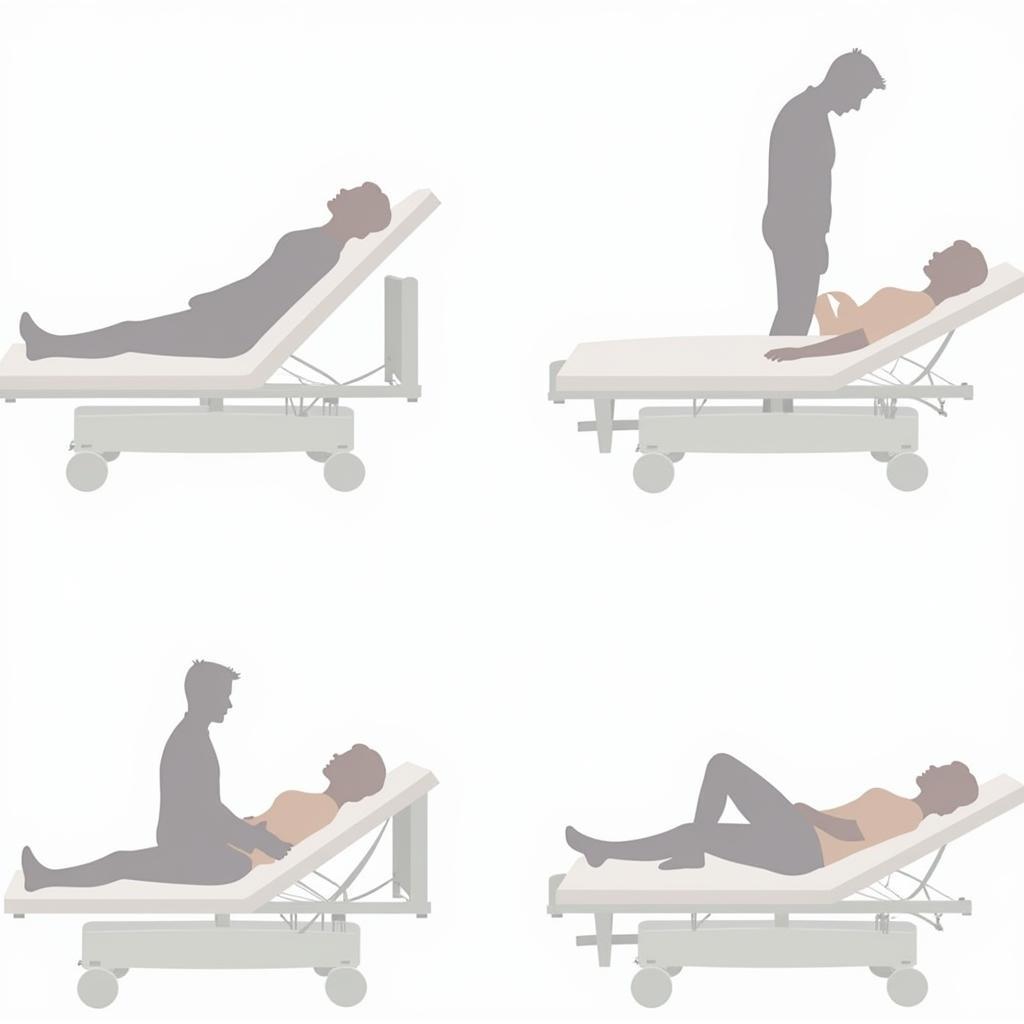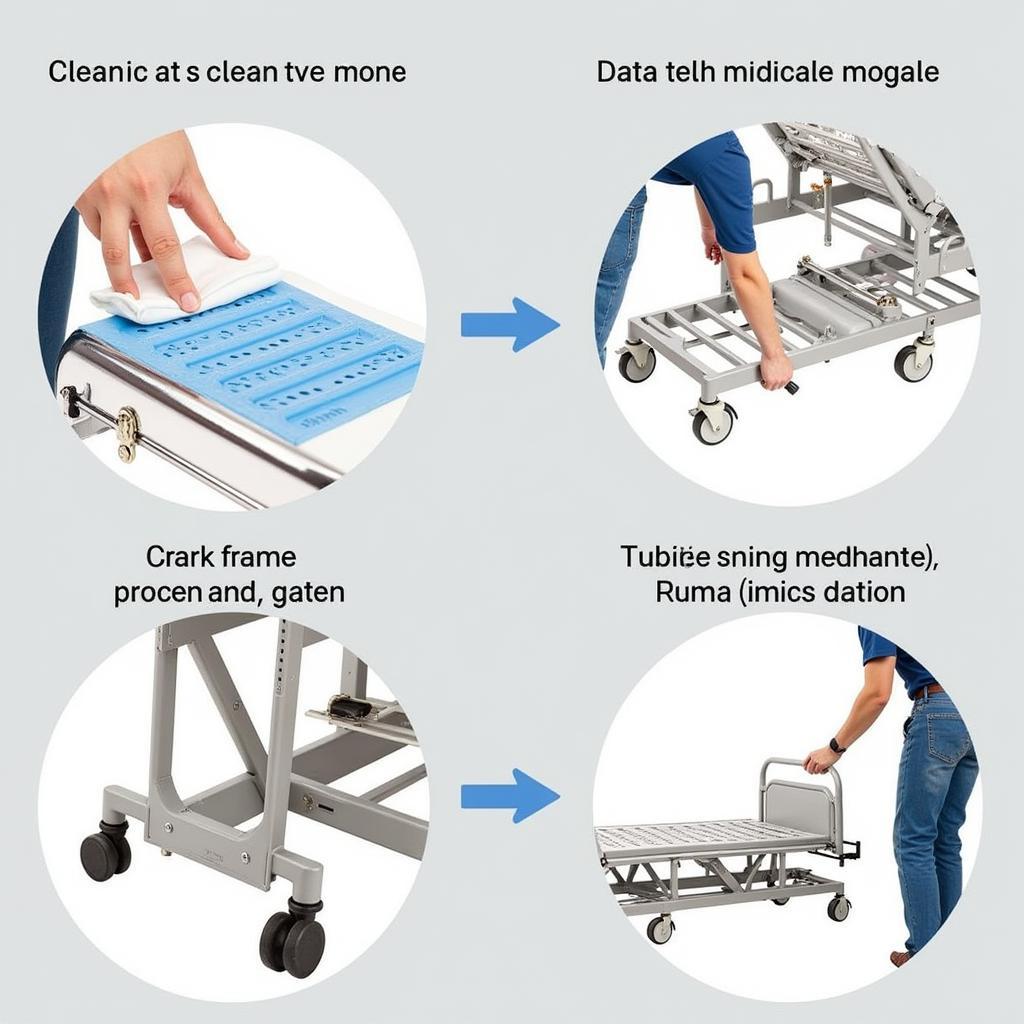Manual Hospital Beds are essential for providing comfortable and safe care for patients requiring extended bed rest. Understanding the various features and options available is crucial for making an informed decision that meets the unique needs of each individual. This guide explores the essential aspects of manual hospital beds, helping you navigate the selection process and ensure optimal patient care.
Understanding Manual Hospital Beds
Manual hospital beds, unlike their electric counterparts, rely on manual adjustments for positioning. These adjustments, typically controlled by cranks located at the foot or side of the bed, allow caregivers to raise or lower the head and foot sections, as well as the overall height of the bed. This functionality promotes patient comfort, assists with essential daily activities, and facilitates caregiving tasks. Choosing the right manual hospital bed can significantly impact a patient’s recovery and overall well-being. For elderly patients, consider specific features that enhance their safety and comfort, such as side rails and adjustable bed heights. You can learn more about specialized beds on our page about hospital bed for elderly.
Key Features to Consider
Selecting the right manual hospital bed requires careful consideration of several key features. The bed’s dimensions, weight capacity, and construction materials play a vital role in ensuring patient safety and comfort. Consider the height and width of the bed frame, ensuring it accommodates the patient’s size and allows for easy movement. Weight capacity is another critical factor, especially for bariatric patients. Lastly, durable and easy-to-clean materials contribute to hygiene and longevity. If you are considering a manual hospital bed for home use and require two beds, explore options like a twin hospital bed for home.
Positioning and Adjustability
The ease of adjusting the head and foot sections is paramount for patient comfort and proper care. Look for smooth and reliable crank mechanisms that allow for effortless adjustments. The range of positions offered by the bed is also crucial, allowing caregivers to find the optimal position for the patient’s specific needs, whether it’s for eating, sleeping, or receiving medical attention.
 Manual Hospital Bed Positioning Options
Manual Hospital Bed Positioning Options
Safety and Accessories
Safety features like side rails and locking casters are indispensable for preventing falls and ensuring patient security. Side rails provide support and prevent patients from rolling out of bed, while locking casters secure the bed in place during transfers and other activities. Additional accessories like overbed tables and IV poles further enhance patient convenience and facilitate caregiving. If you’re looking to purchase a manual hospital bed, search for reputable hospital bed sales near me.
Maintaining a Manual Hospital Bed
Proper maintenance ensures the longevity and functionality of your manual hospital bed. Regularly inspect the frame, cranks, and casters for any signs of wear and tear. Keep the bed clean by wiping down surfaces with a disinfectant solution. Lubricate moving parts as needed to ensure smooth operation. A well-maintained manual hospital bed provides a safe and comfortable environment for patients. Consider reputable brands like Invacare hospital bed for quality and durability.
“Regular maintenance is essential for ensuring the safety and longevity of any manual hospital bed,” advises Dr. Emily Carter, a leading geriatric physician. “By taking the time to inspect and clean the bed, caregivers can prevent potential hazards and ensure optimal patient comfort.”
 Maintaining a Manual Hospital Bed
Maintaining a Manual Hospital Bed
Conclusion
Choosing the right manual hospital beds requires careful consideration of various factors, including patient needs, safety features, and ease of use. By understanding the key features and maintenance requirements, you can make an informed decision that ensures optimal patient care and comfort. Investing in a high-quality manual hospital bed can significantly improve a patient’s recovery experience and provide caregivers with the tools they need to deliver effective care. Remember to consider the specific needs of the patient and consult with healthcare professionals for personalized recommendations. Need more information or assistance? Explore resources like hospital bed rental cincinnati for options in your area.
FAQ
- What is the average weight capacity of a manual hospital bed?
- Are side rails standard on all manual hospital beds?
- How do I adjust the height of a manual hospital bed?
- What is the typical lifespan of a manual hospital bed?
- What are the benefits of choosing a manual hospital bed over an electric one?
- Where can I purchase accessories for my manual hospital bed?
- What are the key maintenance tasks for a manual hospital bed?
Common Scenarios and Questions
-
Scenario: An elderly patient requires a manual hospital bed for home use. Question: What features should I prioritize for elderly patients?
-
Scenario: A caregiver needs to transfer a patient from the bed to a wheelchair. Question: How can a manual hospital bed facilitate safe transfers?
Further Exploration
For more information on related topics, consider exploring our resources on hospital bed safety guidelines and choosing the right mattress for a hospital bed.
Contact Us
For further assistance, please contact us: Phone: 02437655121, Email: [email protected]. Visit us at: 298 Cau Dien St., Minh Khai Ward, Bac Tu Liem Dist., Hanoi, Vietnam. We offer 24/7 customer support.